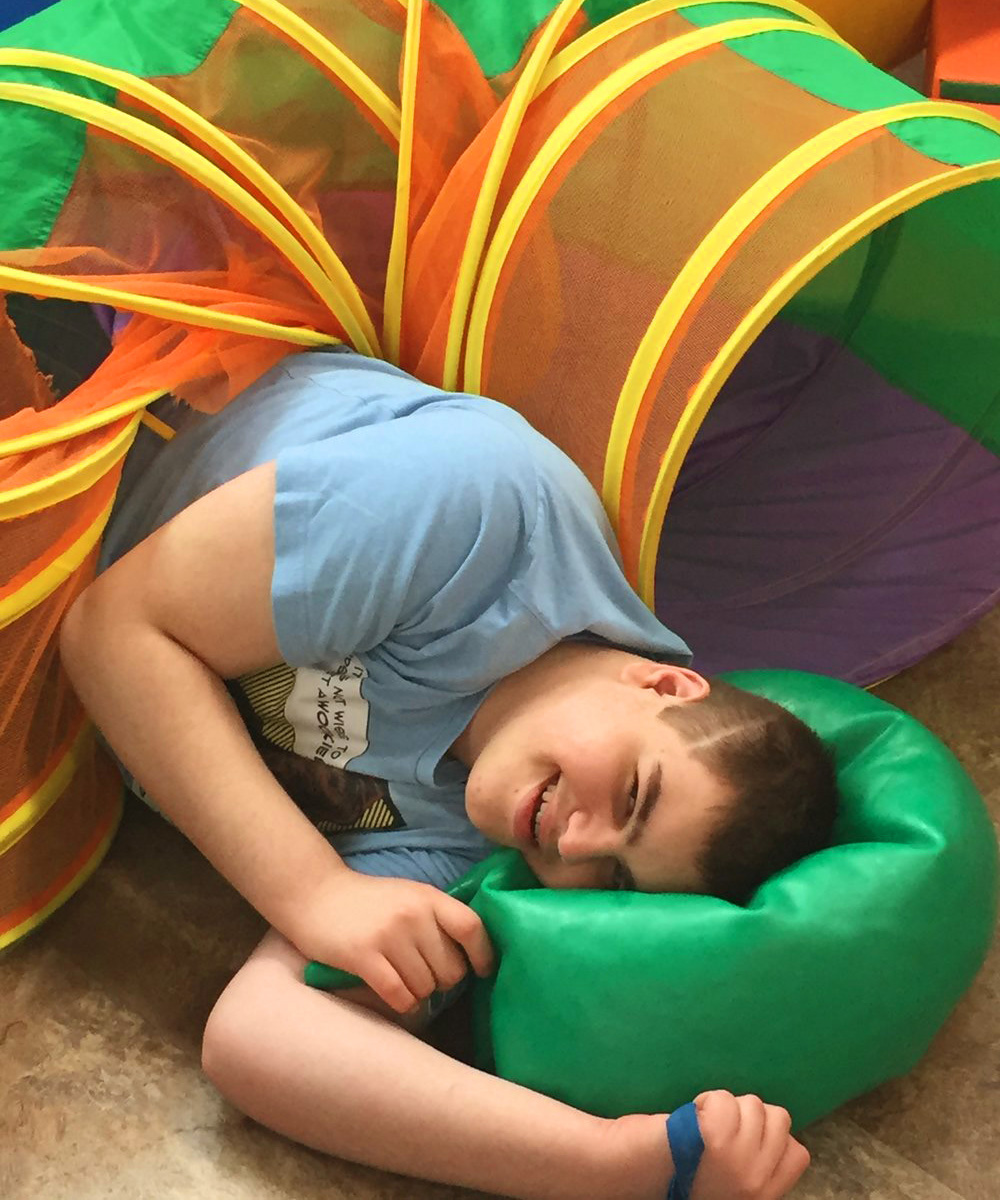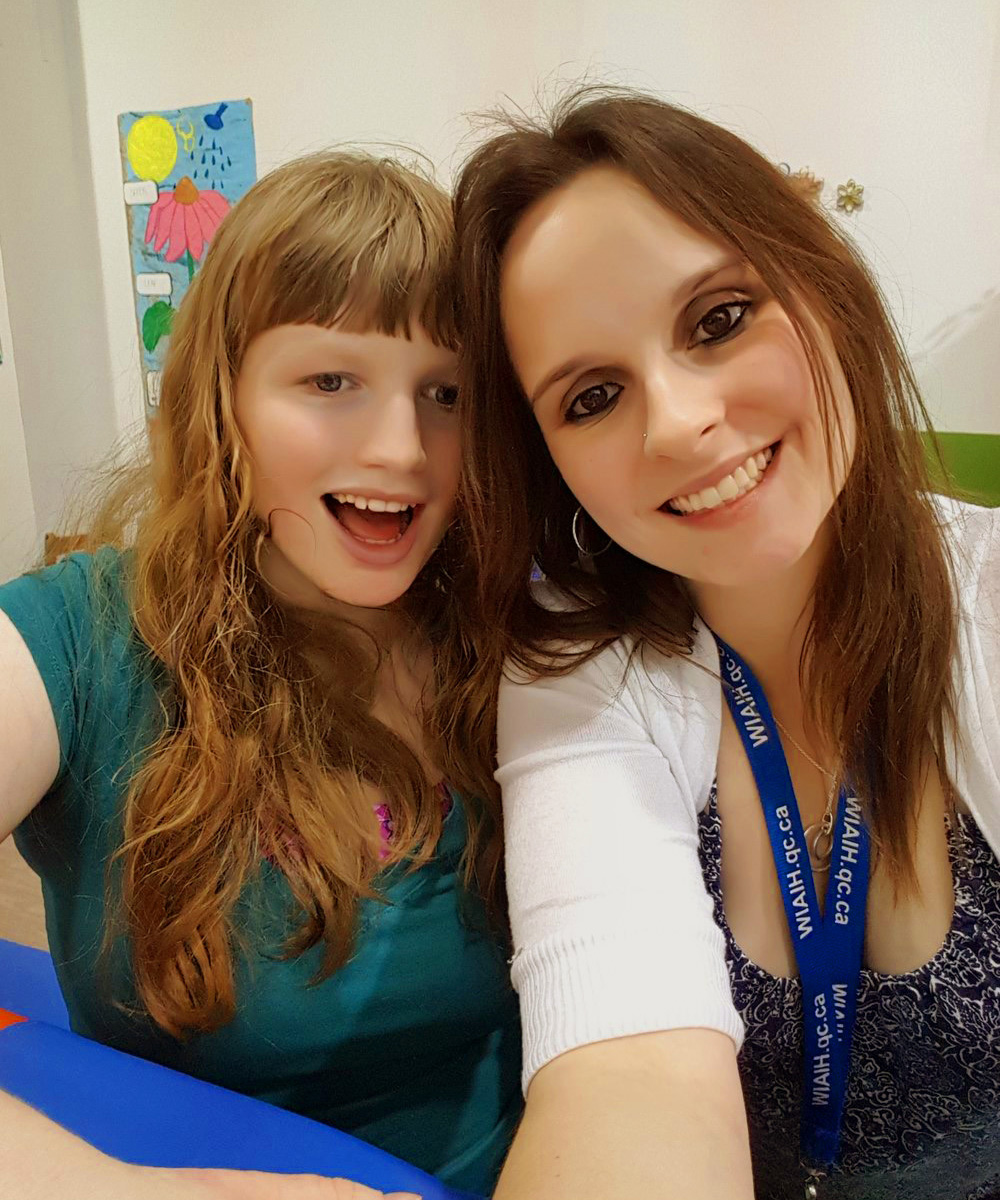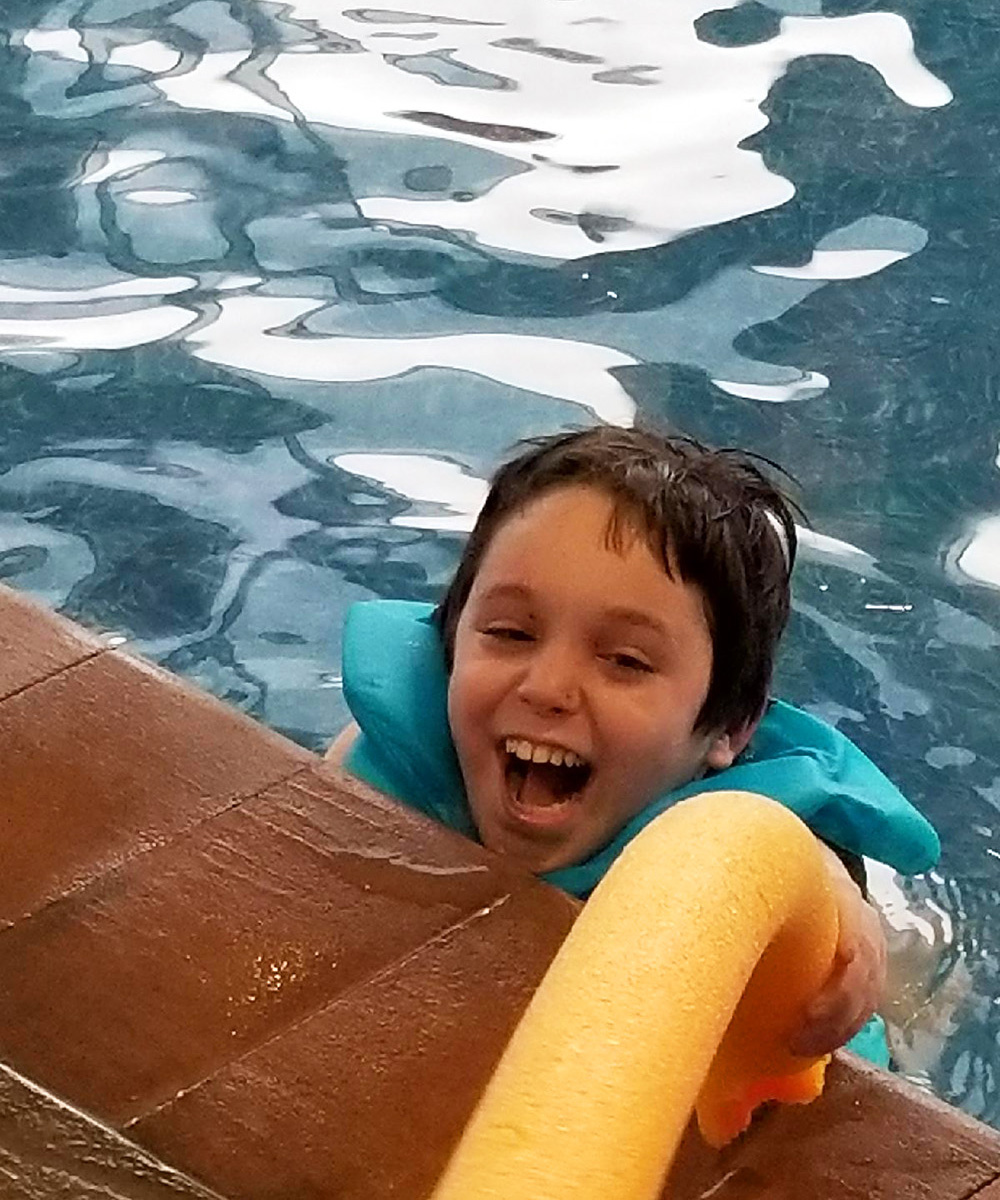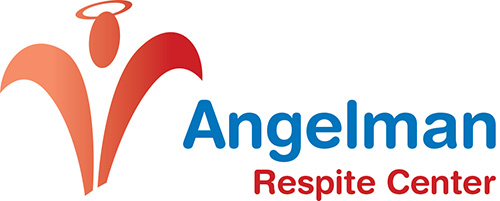
Angelman Respite Center
The center offers many services and much respite to individuals with Angelman syndrome or intellectual disability, living in their natural families. We provide full weekend overnight stays of 30 or 48 hours.
During those stays, the center offers a full range of activities. Don’t hesitate to contact us for more information.
-
Pool
-
Sensory room
-
Gym
-
Arts & crafts
-
Music
-
Playrooms
-
Cooking activities
-
5 bedrooms




Angelman Syndrome
What is Angelman Syndrome?
Angels have curly hair, an enchanting look, a tenderness and a special affection, a catchy smile, a
constant good mood, they are also innocent, carefree, simple, they are awake night and day … Our
children have Angelman syndrome. People with this syndrome are affectionately called Angels.
Angelman syndrome, what is it?
It is a genetic condition that affects the neurological development of the brain in 1/15 000 individuals, about 550 in Quebec. This is manifested by a severe overall developmental delay of various motor
disorders, intellectual disability, lack of oral language, hyperactivity, a very often happy demeanor, sleep
disorder and epilepsy for the majority.
This condition is genetic, which means that there is a defective gene, the UBE3A gene on chromosome
15 from the mother. Since this gene is missing or malfunctioning, there is a whole complex series of
protein interactions in the brain that is missing, leading to developmental delay.
People who live with this syndrome have a normal life expectancy.
However, they need lifelong support and for the moment, they cannot gain sufficient autonomy to be
independent.
Typical features found in those with Angelman:
• Normal prenatal and natal history with normal head circumference and no congenital abnormalities.
• Normal metabolic, hematological and biochemical blood draw.
• Cerebral magnetic resonance in the normal ensemble and elements such as mild atrophy and / or
demyelination can be found.
• Global development delay without loss of learning, obvious from 6 to 12 months old.
• Language disorder, few pronounced words, receptive language and nonverbal communication better
than expressive language.
• Movement disorders, especially ataxia and / or limb tremor.
• Unique behavioral trait of happy temper with a tendency to smile and laugh frequently; hyperexcitable
with flapping hands; hypermotric behavior and reduced attention.
Characteristics found> 80% of individuals
• Slow growth of the head resulting in microcephaly
• Epilepsy that usually begins before the age of 3
• Abnormal electroencephalogram (EEG) with a characteristic pattern
(The literature speaks of 3 characteristic patterns like waves of large amplitudes)
Characteristics found <80% of individuals
• Flat back of the head (occiput)
• Protruding tongue
• Swallowing disorders (dysphagia)
• Hypotonia (low muscle tone)
• Prognathia (When the jaws are not aligned properly and the chin seems to move forward with respect
to the upper jaw)
• Wide mouth with space between the teeth
• Drooling
• Like to put things in their mouth
• Strabismus
• Clear skin as well as eyes and hair (only in individuals with a deletion)
• Sharp reflex in the lower limbs
• Bent arms raised in the air, especially during walking
• Wide gait (the feet are far from each other) and the ankles are turned inwards (pronation / valgus)
• Hypersensitive to heat
• Sleep disorders such as altered sleep-wake cycles and decreased sleep requirements
• Fascination for water, textured objects
• Abnormal behavior related to food
• Obesity (adult and especially those who have no deletion)
• Scoliosis
• Constipation
Genetic and Diagnostic
Some notions of genetics to understand the different types of chromosomal
abnormalities that cause Angelman syndrome.
• We have 23 pairs of chromosomes (one comes from the father and the other from the mother:
paternal / maternal chromosomes)
• In each chromosome, there are thousands of genes (they are pieces of DNA that are equivalent to
codes giving instructions to produce proteins)
• Normally we have 2 copies of the same gene in our body (one on the maternal chromosome and the
other on the paternal chromosome)
• The UBE3A gene codes (owns information) for a protein called ubiquitin ligase E6. This protein is
important for the normal functioning of neurons in the brain.
• The loss or malfunction of the UBE3A gene, located on maternal chromosome 15 (region q.11-q13),
causes symptoms of Angelman syndrome.
• For some reason, there is a genomic imprint on the paternal UBE3A gene in the brain. A genomic
imprint is the addition of molecules that will disable the gene. So there is somehow a STOP on the
paternal UBE3A gene. So there is only one UBE3A functional gene in the brain at the maternal
chromosome level, for every non-Angelman person.
• There are 4 mechanisms that will cause the loss of the UBE3A gene (hence an absence of protein E6
ubiquitin ligase or inadequate protein)
DELETION (70 %) Uniparental (5 %) MUTATION (5-10%) Printing default (5%)
Disomy
DELETION: This is a more or less loss (deletion) of part of the 15q11-q13 region of the maternal
chromosome. There are several genes missing including the UBE3A gene. There are also 2 subtypes in
this class, those of type 1 which have a deletion of more than 5 Mb (they are millions base pairs, these
letters which constitute the DNA) and the classes 2 which have a deletion less than 5 Mb. In general,
the larger the deletion, the more severe are the symptoms.
UNIPARENTAL DISOMY: This is when the person inherits 2 copies of the paternal chromosome 15. Since
the UBE3A gene is inactive in both paternal chromosomes, there is no functional UBE3A gene.
MUTATION: In these cases, there is an abnormality within the UBE3A gene itself, which means that the
protein is completely absent or if it is produced is not functional.
IMPRINTING DEFECT: There is an imprinting defect on the maternal gene, in other words, it is as if a
STOP has been added to the gene, therefore, it cannot express itself (it cannot produce ubiquitin ligase
protein E6).
CLINICAL ANGELMAN SYNDROME: 5-10% of cases. No anomaly has been identified, but these people
have several characteristics named above. Either there are other molecular mechanisms that we do not
yet know that cause the loss of the functional UBE3A gene or that they have another unidentified
genetic disease.
Diagnosis rarely occurs at birth. Diagnosis investigation is needed between the age of 6 months to 1 year
when developmental delay becomes more obvious.
We are talking about diagnostic investigation, because in some cases the diagnosis can take up to 1 year
before becoming certain. This is because it takes several tests (and some tests take up to 3 months to
obtain the results) for some individuals before confirming Angelman syndrome. As previously explained,
there are four genetic mechanisms that can explain the loss of the UBE3A gene, so you have to look for
them one by one if there is a suspicion of Angelman syndrome.
Here are the different tests:
• Genomic comparative hybridization technique on microarray CGH (DNA chip): will highlight losses or
gains of chromosomal material which means that this test will allow seeing if there are deletions (holes)
or duplications of DNA.
• FISH: fluorescence in situ hybridization: In summary, gives the same information as the CHG but it is
done on one chromosome at a time.
• DNA methylation test: to see if both copies (alleles) of a gene are active and present. What you should
know is that there are different methyl groups (molecules added on DNA) on the paternal and maternal
chromosome too. And it is this difference that allows us to distinguish between the two chromosomes.
Remember that Angelman syndrome results from a defect of a gene in the maternal chromosome.
There is another syndrome, Prader -Willi syndrome, which results in dysfunction of a similar region as
the Angelman region (q11-q13) but on paternal chromosome this time. The methylation test makes this
difference. An individual who has a deletion will have a positive methylation test because he misses a
portion of the chromosome and that will detect it.
• The PCR (polymerase chain reaction) test will be used to detect paternal disomy and imprint defects.
The methylation test is positive but the CGH or FISH is normal. The PCR will allow us to see in a first case,
for uniparental disomy, that they are 2 paternal copies. The other case, for the imprint defect, there is a
defect in the methyl groups (which serve to give the green light to the reading of the gene) which is
detectable by PCR and therefore will give the diagnosis.
• In some cases, all these tests are normal (CGH / FISH, methylation test / PCR). It is then necessary to
analyze the UBE3A gene for a small defect. This is called sequencing of the UBE3A gene.
• And in a small percentage, all these tests are normal and these children have clinical Angelman
syndrome. As said before, there might be other molecular mechanisms that we do not yet know, leading
to the loss of the functional UBE3A gene or they have another unidentified genetic disease.
Here is a list of differential diagnosis to consider when the genetic testing is inconclusive or clinical.
• Cerebral palsy
• Non-verbal autism
• Prader -Willi syndrome
• X-linked mental retardation
• Rett Syndrome
• Phelan-McDermid syndrome (chromosome deletion 22q13.3)
• Mowat-Wilson syndrome
• Smith-Magenis syndrome
• Monosomy syndrome 1p36
• Pitt-Hopkins Syndrome
• HERC2 Mutation also known MRT38 -autosomal recessive
• Chromosome microdeletion syndrome 17q21.31
• Syndrome with TRAPPC9 gene mutation
• Microdeletion 2q23.1 (Pseudo-Angelman syndrome)
• Duplication 15q
Possibility of genetic transmission
1. Deletion:
The majority of cases of maternal chromosome 15 deletion occur by a spontaneous event (de novo) and
are therefore not inherited; the risk of transmission is minimal for these families. However, 1-2% of
deletions are due to an inherited chromosome 15 abnormality of the mother.
2. Uniparental paternal disomy
The majority of cases of uniparental paternal disomy occur as an apparent spontaneous event (de novo)
therefore non-hereditary. We must still exclude the rare possibility of inheritance from the mother so a
chromosome analysis of the mother is required.
3. Imprint defect:
There are two types of defects; deletions and non-deletions. The latter do not seem to be inherited and
therefore present a low transmission risk of <1%. For deletions, there is a risk of inheritance and they
confer a risk of transmission of 50%.
4. UBE3A mutations:
The UBE3A mutation can occur spontaneously in 70% of cases. It is hereditary in 30% of cases and has a
risk of transmission of 50% (see below – hereditary transmission – for explanation).
5. People without a known mechanism (the 4 mechanisms above have been eliminated):
For those who have a clinical diagnosis we do not know what is the risk of transmission.
6. Germ cell mosaicism:
This rare mechanism has already been observed.
This term refers to a phenomenon in which a genetic abnormality is present in the gonad cells (ovary in
the case of the mother) but not in other cells of the body. There is a risk of error in the assessment of
the risks of transmission because the blood test evaluates the cells that are in the blood only. In fact, in
these cases, a genetic abnormality is present in the germ cells of its ovary. The geneticist will be able to
tell you if it is necessary to do such a test.
Hereditary transmission
• Basic elements: The squares represent the masculine gender and the circle the feminine gender.
• The union between a woman and a man who has fathered children is represented by a horizontal line
between the two and their descendants are below.
• The carrier state is represented with the dot and the lighter color indicates that the person has
Angelman syndrome.
Let's start:
Since Angelman syndrome has a genomic imprint, hereditary transmission is peculiar and is different
from many other hereditary diseases. Remember that the paternal chromosome is silenced in the brain
for the UBE3A gene, so a single UBE3A gene is active on the maternal side. The functional loss of the
maternal UBE3A gene leads to the syndrome.
This means that an individual (whether male or female) who has a defect in his paternal UBE3A gene
(chromosome received from his father) will be asymptomatic. This individual is said to be a carrier.
A woman who is a carrier will have a 50% chance in each pregnancy of having a child with Angelman
syndrome. This is because, for every child she conceives, she gives either her maternal chromosome or
her paternal chromosome. So the possibilities of transmission are 50%.
If the child of this carrier mother, be it girl or boy, receives the defective paternal chromosome of his
mother, he will have Angelman syndrome because his chromosome, since it comes from his mother
becomes a maternal chromosome. This is what we see in the table, 2 carriers mothers who have
affected children, one of whom has a boy and a girl.
A man who is a carrier (defective chromosome paternal gene) will never have a child affected but can
transmit to each child 50% of possibility of being a carrier (whether he is a girl or a boy). His children
receive their father's chromosome so it's a paternal chromosome.
The man thus transmits the state of carrier (50%) and the women can give birth to children who have
the syndrome (50%). This mutation transmission can cross several generations before seeing an
individual affected.
Multi-modal Care
There is currently no cure for Angelman syndrome. Instead, global and multidisciplinary interventions on
various spheres of development have to be implemented.
This is a non-exhaustive list that varies over time according to the needs of the child and the family’s
medical accompaniment.
Medical sphere:
• Long-term follow-up: These children are often followed by pediatricians or family physicians with
expertise in global developmental delays for long-term care. There is more gastroesophageal reflux (due
to hypotonia), constipation (lack of fluid intake), sleep disorder requiring medication, infections of the
respiratory tract and ears (put everything in the mouth), tendency to obesity into adolescence and adult
life, osteoporosis (decreased physical activity and side effect of anticonvulsants).
• Epilepsy: Follow-up by neurologists for the treatment and management of epilepsy. Warning; some
movement disorders (tremor, ataxia) can be taken for epilepsy and thus overmedication.
• Motor disorders: Physiatrist support is needed to monitor various motor disorders. They will prescribe
inter alia, orthotics for these children who often have hyperlaxity ligament (pronation or supination).
They work in concert with the orthotist who molds the braces. There may also be hypertonia in some
cases or ligament retractions. The physiatrist also prescribes technical aids for walking and mobility aids
such as adapted strollers, walkers and wheelchairs, etc.
• Scoliosis: There are sometimes surgical procedures by the orthopedist, for example; a severe scoliosis.
• Strabismus: Ophthalmological consult is also necessary when the child has strabismus. We can also see
keratoconus (deformation of the cornea), refractive error (myopia, presbyopia etc.), cortical blindness
etc.
• Drooling: ENT management may be necessary for botox treatments or surgery to reduce salivation.
Regular follow-up by a dentist is suggested.
Global motor skills:
Physiotherapy helps achieve or maintain motor autonomy through all stages of motor development,
from rolling/crawling to walking. The average age of acquisition of walking is 3-7 years. Unfortunately,
about 10% of individuals will never walk and some will lose this skill. With the help of the
physiotherapist (in collaboration with the physiatrist,) assistive devices such as a walker, a standing
board or other equipment may be recommended depending on the child's progress. Several exercises
are carried out in order to ensure a better posture, reinforce the protection mechanisms in case of a fall,
etc.
Fine motor skills:
The occupational therapist works to promote the acquisition of daily autonomy such as the realization
of personal care; to eat alone, to dress, wash, move, perform significant leisure and participate in
productive activities including promoting the integration with daycare and school. For each of these
activities, the occupational therapist may suggest compensating strategies or environmental
modifications based on the identified difficulties. For example, a program of therapeutic activities may
be recommended to improve abilities, technical aids to facilitate participation in a lifestyle or home
improvement, etc.
Together with the physiotherapist, they will also highlight sensory integration disorders in these children
and work on them.
Sensory integration is a neurological process in which the brain records, differentiates and modulates
sensory stimuli (vision, smell, hearing, taste, touch, movement, balance) coming from the child's body
and its environment. The acquisition of all these senses allows the body to interact with the
environment and react appropriately.
To learn more about sensory integration: http://www.irdpq.qc.ca/publications-de-lirdpq/comprendre-
lintegration-sensorielle
The occupational therapist can also intervene in collaboration with the speech therapist when there are
swallowing problems as well. Examinations such as videofluoroscopy may be recommended to clearly
visualize the ability to swallow or not. A modification of the texture of the food can be indicated in case
of problem (dysphagia).
Communication: speech therapy management:
Angelman children have complex communication needs because they are nonverbal. Their
understanding of language (receptive) is much greater than the expression. The speech-language
pathologist helps to acquire skills called communication prerequisites: visual and auditory attention and
conjoint attention, pointing, turn of speech, role of cause and effect, object’s permanence.
In parallel with these skills, an alternative communication tool (other than the oral language) must be
introduced. Sign language (animated hands) is taught but also a non-oral communication system or
augmented alternative communication (AAC) must be put in place. There are several CAA tools and a
second-line speech pathology assessment must be done at this level.
Special Education:
These are technicians who practice the methods to be used according to the objectives set by the
professionals, the physiotherapists, occupational therapists and speech therapists. They accompany
families and children on a regular basis in their living environment.
They work a lot on behavioral problems that individuals may have with Angelman syndrome related to
intellectual disability, language impairment and sensory integration disorders.
The Research
Although currently there are no curative therapies, several researches are underway, mainly in the
United States, to hopefully treat this condition one day.
It was established in 1996 that the gene responsible for Angelman syndrome is the UB3A gene. The
resulting protein, ubiquitin ligase E6, mediates multiple cellular responses at the neuron level and
performs many functions that we still do not fully understand today. What we do know is that the
UBE3A gene is involved in tonic inhibition. The brain needs a balance between excitatory function
(noise) and tonic inhibition (silence). This makes it possible to connect neurons together at the right
moment (activate-excite) and also to deactivate them at the right moment (inhibition-silence). This
combination of excitement and inhibition is absolutely necessary for the proper functioning of the body
and the brain. Messages between neurons are transmitted and called neurotransmitters. The main
inhibitory neurotransmitter is GABA. We know that the loss of the UBE3A gene leads to a loss of the
tonic inhibition or a deficiency of GABA. Individuals with the syndrome therefore have more excitations
than inhibitions in their brain and this is observable in several symptoms: hyperexcitability, sleep
disorder, epilepsy, tremors, poor coordination, motor disorders, and limited attention span.
We will see further a possible avenue in terms of GABA treatment.
In summary, 3 possible avenues are currently in research
1) Gene therapy. This therapy consists of replacing the missing copy of the UBE3A gene.
• The genes code for proteins, so either replace the defective gene or replace the missing protein.
• This is done using viral vectors to transport the missing gene into brain cells (neurons). A viral vector is
like a car carrying a passenger; the UBE3A gene. The viruses used do not cause disease and come from
the family of adeno-associated (AAV) or lentiviruses.
2) Rewriting genetic material or correcting DNA
• Use of molecules such as ASOs (antisense oligonucleotides) or nucleases such as Zinc Fingers or CRISPR
/ Cas9. Although the two classes of molecules are different, they will ensure that the paternal UBE3A
gene is activated and that the cell can finally produce the protein (E6 ubiquitin ligase). It will be
remembered that there is the equivalent of a STOP on the paternal UBE3A gene. These molecules will
stop the paternal STOP signal and thus restore an adequate level of protein.
3) Downstream therapies. These are therapies that treat the symptoms downstream of the initial
problem (the missing gene) therefore do not provide complete healing but can have a considerable
impact on the quality of life and autonomy of individuals.
• GABA agonist (gaboxadol / OV101): a molecule that replaces GABA and attempts to restore tonic
inhibition. Clinical study in progress to phase III in 2019.
• Ketone supplements (in study)
-Sleeping medication
• Anti-epileptic
• Ketogenic diet or low glycemic diet
• Drugs for constipation
In summary, our children are missing a single gene on the approximately 20,000 genes that
exist. This missing gene causes overexcitation of the brain and loss of tonic inhibition. We can
either replace the missing gene or activate the silent paternal gene.
It is a problem of biochemistry of the brain and not a degenerative problem. Neurons are
anatomically normal, but they have poor communication (synapse). To give them back the
function of UBE3A would give them a chance for a more normal life.
